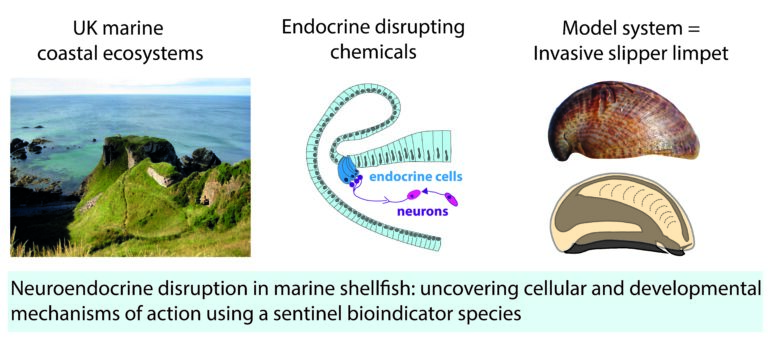Project Description
BACKGROUND: A major component of anthropogenic change is the release of pollutants into the environment. Endocrine Disruptors (EDs) are important pollutants found in wastewater effluents that alter the normal functioning of the endocrine system. EDs released into the environment are of particular concern as the neuroendocrine system is responsible for regulating a complex array of whole organism physiologies such as: stress responses, development, metabolism, growth, immune responses. EDs can have dramatic effects on physiology at very low concentrations (ng/L) and can have transgenerational consequences by effecting both the exposed individual and its offspring.
EDs found in the environment include polychlorinated biphenyls (PCBs), organochlorine pesticides, plasticizers, surfactants and pharmaceuticals. This project will focus on pharmaceutical EDs that are specifically designed to target the endocrine system of humans. They are widely prescribed drugs and have a direct route to aquatic and marine ecosystems via water treatment plants. For example, in 2021, nine out of ten wastewater effluents tested in the UK and Europe contained an ED called dutasteride, commonly used to treat prostate cancer, at concentrations between 6-127 ng/L [1].
To date, most research has focussed on pharmaceutical ED exposure in vertebrates, as the effects often mirror the target human mode of action. It was initially thought that invertebrates would not be affected by pharmaceutical EDs as their endocrine systems are divergent and fundamentally different to vertebrates. Surprisingly, research is beginning to document that pharmaceutical EDs dramatically affect the neuroendocrine system of invertebrates [2].
Despite the importance of the neuroendocrine system in regulating whole organism physiology, it is not well characterised in invertebrates, especially molluscs. Yet, in terms of biomass, biodiversity, and functional trait diversity, molluscs are essential components of every aquatic ecosystem in the UK, as well as being important harvest and aquaculture industries in Scotland and Northern Ireland. This project will study the mode of action of pharmaceutical EDs using an environmentally and ecologically sentinel species – the invasive slipper limpet Crepidula fornicata. This species is invasive to the UK and causing damage to native biodiversity, such as oyster reefs. It is also an established cell and developmental model system and hence is the perfect species in which to characterise the development of the neuroendocrine system of molluscs and test the effect of environmentally relevant pharmaceutical EDs.
PROJECT AIMS
1.) Characterise the development of the neuroendocrine system in molluscs
2.) Systematically test the effect of known environmentally relevant neuroendocrine disrupting chemicals (such as dutasteride) on developmental processes in molluscs
3.) Extrapolate the effects measured in individuals to impacts on populations
METHODS
1.) Characterise the development of the neuroendocrine system in molluscs
Transcriptomic data (already collected) will be used to describe the development of the neuroendocrine system. Established microscopy methods will map the connection of neurons and endocrine cells (lead supervisor has data analysis expertise and methods working in-house [ 3]).
2.) Systematically test the effect of known environmentally relevant neuroendocrine disrupting chemicals (such as dutasteride) on developmental processes in molluscs
Embryos of C. fornicata will be exposed to a range of concentrations of dutasteride (and other pharmaceuticals) to establish dose-responses (ngs/L to ugs/L [ 1]). Developmental processes will be assayed as readouts of the dose-response experiments for example: cellular behaviour, morphology, gene expression.
3.) Extrapolate the effects measured in individuals to impacts on populations
Exposures will be conducted as in objective 2, but the readouts will be larval behaviours such as dispersal tendency, and settlement preferences. By studying larval behaviours we can extrapolate from mechanistic understanding of ED action in developmental stages to behavioural variation that effect planktonic distribution and survival and therefore impacts on ecosystems.
CANDIDATE BACKGROUND
Essential:
• An excellent degree (2:1 or higher) in a relevant BSc (for example Marine Biology, Zoology, Biological Sciences)
• A passion for undercovering the biological mechanisms underpinning the effects of environmental pollutant on ecosystems
• Experience conducting independent research in a relevant field
• Proven track-record in self-driven motivation and an ability to deliver results independently
• Proven track-record in independent, creative problem solving
Desirable:
Any combination of the following experience:
• Experience in physiological assays, especially in relation to developmental pathways and gene expression
• Experience in bioinformatic analysis of large datasets
• Experience in behavioural assays
• Experience in aquatic invertebrate husbandry
Image credit: Vicky Sleight
Supervisors
Vicky SleightPrimary Supervisor: | Profile: Vicky Sleight Email: Victoria.sleight@abdn.ac.uk Institution: University of Aberdeen Department/School: School of Biological Sciences |
Gary HardimanSecondary Supervisor: | Profile: Gary Hardiman Email: g.hardiman@qub.ac.uk Institution: Queen's University, Belfast Department/School: School of Biological Sciences |
David N. FisherAdditional Supervisor: | Profile: David N. Fisher Email: David.fisher@abdn.ac.uk Institution: University of Aberdeen Department/School: School of Biological Sciences |
Jaimie TA DickAdditional Supervisor: | Profile: Jaimie TA Dick Email: j.dick@qub.ac.uk Institution: Queen's University, Belfast Department/School: School of Biological Sciences |
Additional Supervisor: | Dr Alice Baynes (ecotoxicologist), Brunel University London |
References
- Gómez-Canela, C., et al., Comprehensive Characterization of 76 Pharmaceuticals and Metabolites in Wastewater by LC-MS/MS. Chemosensors, 2021. 9(10): p. 273.
- Katsiadaki, I., Are marine invertebrates really at risk from endocrine-disrupting chemicals? Current Opinion in Environmental Science & Health, 2019. 11: p. 37-42.
- Rees, J.M., Sleight, V.A., et al., Ectodermal Wnt signaling, cell fate determination, and polarity of the skate gill arch skeleton. Elife, 2023. 12(e79964).
QUADRAT Themes
- biodiversity
- environmental-management






















































